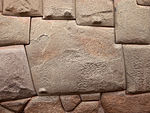
A maloca is an ancestral long house built by Indigenous people of the Amazon, notably in Colombia and Brazil. Each community has a single maloca with its distinct characteristics.
Several families with patrilineal relations live together in a maloca, distributed around the long house in different compartments. In general, the chief of the local descent group lives in the compartment nearest to the back wall of the long house. As well, each family has its own hearth.
During festivals and in formal ceremonies, which involve dances for males, the long house space is rearranged; the centre of the long house is the most important area where the dance takes place. Each maloca has two entrances, one for men and one for women. Married men and women sleep together, and unmarried men and women sleep separately. A maloca is traditionally surrounded by two gardens: the inner called the kitchen gardens (growing plants such as bananas, papaya, mango, and pineapple) and the manioc gardens growing manioc (yuca).
See also
- Maloca is also a synonym for malón, a Mapuche raid.
- Jesuit Missions of Chiquitos, partly inspired by indigenous architecture
References
- Gutierrez, Maria Paz (March 2020). "The Northwestern Amazon malocas: Craft now and then". Journal of Material Culture. 25 (1): 3–35. doi:10.1177/1359183519836141. ISSN 1359-1835. S2CID 150987018.
- Goldman, Irving (1979). The Cubeo Indians of the Northwest Amazon. University of Illinois Press. ISBN 978-0-252-00770-5.
External links
- La Maloca de los Sabedores de Oscar Freire
| Hut dwelling designs and semi-permanent human shelters | ||
|---|---|---|
| Traditional immobile |
|  |
| Traditional mobile | ||
| Open-air | ||
| Modern | ||
| Related topics | ||
| Native American architecture | ||
|---|---|---|
| Styles |  | |
| Building types | ||
| Structures | ||
| Elements | ||
This article relating to anthropology is a stub. You can help Misplaced Pages by expanding it. |